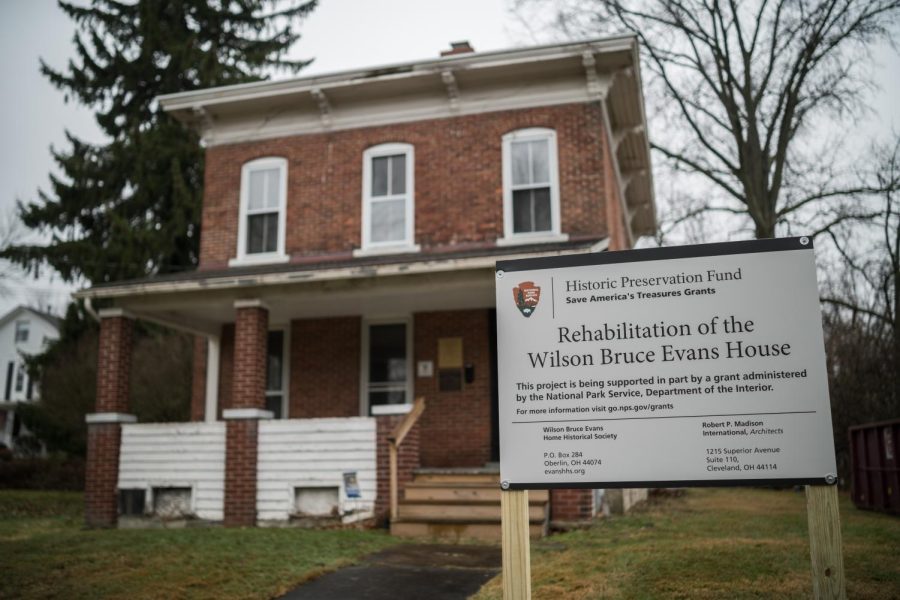Wilson Bruce Evans Home Historical Society Commemorates African-American History at Oberlin
The Wilson Bruce Evans Home Historical Society celebrated the kickoff of a major restoration project Nov. 12. The organization plans to restore the Wilson Bruce Evans Home, a registered national historic landmark built and inhabited by Wilson Bruce Evans, a Black abolitionist who was active in the Oberlin community during the Civil War.
The restoration was made possible by a $283,250 grant from the National Park Service. Only 80 of these grants were awarded this year, and the home is the only recipient in Ohio. The organization hopes to use the house to tell the story of its builder and first resident and to educate the community about local African-American history.
Wilson Bruce Evans was born a free man in North Carolina in 1824. In 1854, he and his wife, Sarah Jane Leary Evans, relocated to Oberlin, where his brother, Henry Evans, had already settled. As soon as they arrived in Ohio, the Evans family became involved in anti-slavery activity. Their home was used to house fugitives on the Underground Railroad, and in 1858, when a fugitive was captured in Oberlin, Wilson and Henry Evans were among those who rescued him in what would become famously known as the Oberlin-Wellington Rescue.
“The Evans family is very important in the radicalization of the anti-slavery movement in Oberlin,” Carol Lasser, manager of the Wilson Bruce Evans Home Historical Society and former professor of History at Oberlin College, said. “Black abolitionists in general are very important in getting white abolitionists to understand that slavery isn’t going to just wither away, that it’s going to take confrontation and eventually the violence of war.”
Wilson Bruce Evans later served in the Union army and was related to the two Oberlinians who participated and lost their lives in John Brown’s raid on Harpers Ferry, which was intended to start a national uprising against slavery.
The home, located on East Vine Street, remained in the hands of Evans’ family and descendants from when it was built in 1856 until last year, when the family created the Wilson Bruce Evans Home Historical Society for its preservation. The organization hopes to open the restored home to the public as a museum and a center for African-American history education in Oberlin.
“[The house’s] historical nature makes it a living museum,” Catherine Grooms, treasurer of the Wilson Bruce Evans Home Historical Society and direct descendant of Wilson Bruce and Sarah Jane Leary Evans, said. “It will be used as a history-sharing space. It will be used as an educational space for the community.”
Vice President of the Wilson Bruce Evans Home Historical Society Phyllis Yarber Hogan hopes the house will be used to educate people about Oberlin’s untold history — beyond just the Evans family. Hogan said she never learned local history growing up in Oberlin and attending Oberlin public schools, and it was only as an adult that she started doing her own research.
“It’s important to me because I know how ignorant I felt not knowing anything about Oberlin’s history … and I don’t want any other young person to feel that way,” Hogan said. “Just knowing the history gives you an understanding of your own identity and your value and your rights and your responsibilities.”
Aside from its connection to important events in the abolition movement, the house is also important as a symbol of the Evans family’s hard work and prosperity. The house, which contains much of Wilson Bruce Evans’ original woodwork, is a testament to both his carpentry skills and his success in business.
“The historical significance of a person of color owning property is absolutely significant,” Grooms said. “It was significant then, and it is significant today in 2022.”
Lasser echoed Grooms’ thoughts on people of color owning the property.
“I think it’s also really important for Americans, Black and white, to recognize that this lovely and substantial house … was occupied by people of color — that not everybody was an impoverished fugitive from slavery,” she said.
The vision for spreading awareness and education of Oberlin’s African-American history expands beyond the house on Vine Street. “We think that restoring the Wilson Bruce Evans house will be a spark to ignite a larger preservation movement in Oberlin that will help us to really make it a destination for African-American heritage tourism,” Lasser said.
Hogan said she hopes that the restored Wilson Bruce Evans Home will bring attention to the other historic homes and African-American churches in the southeast quadrant of Oberlin.
“I’m hoping … the history that’s in that area can make it a place to be visited to understand Oberlin,” Hogan said.
A lot more work needs to be done before any of these plans come to fruition, but there is enthusiasm from those involved. From the Oberlin College ultimate Frisbee teams setting up chairs for events to local tradespeople and business owners donating their time and skills, the community has supported the project in a variety of ways.
“It’s not glamorous work right now,” Lasser said. “It’s the tedious work. We have another couple of years of heavy lifting, and I’m just really, really grateful to the family and to the people of Oberlin who have really stepped forward.”







